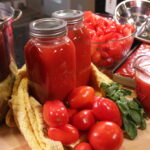Tomato Passata
If you have enjoyed tomato sauce made with fresh summer tomatoes, then you will appreciate having a supply of passata throughout the rest of the year. Preserving tomato purée captures that memorable flavour so you can enjoy it in many different recipes. The best thing is that you don't need fancy equipment but you do need the best tomatoes you can find!
Yield: 16 cups
Equipment
- food mill
- Large pot to boil chopped tomatoes
- paring knife
- Various sized bowls
- immersion blender, optional
- Ladle or liquid measuring cup
- Clean kitchen towels or paper towels
- If canning by water bath method, you will need 4 clean 1-quart canning jars, large mouth funnel, pot large enough to totally immerse jars, jar handles, 4 two-piece lids, 2 clean dish towels.
- If canning by quick vacuum method, you will need 4 clean 1-quart canning jars, large mouth funnel, 4 two-piece lids, and nonslip oven mitts, rimmed cookie sheet.
- If preserving by freezing, you will need 4 - 6 large freezer bags, labeled and dated, a rimmed cookie sheet.
Materials
- 10 pounds tomatoes Use a variety - ex. plum, Roma, San Marzano
- 4 - 6 sprigs fresh basil, washed and dried
Instructions
Preparing the tomatoes:
- Ensure that you have a very clean work space including your counters, sink, and utensils for preserving the passata. Place the tomatoes in a sink full of water. Add a little produce wash if you like. Use a veggie scrub cloth to wash each tomato. Rinse well and place in a large bowl.
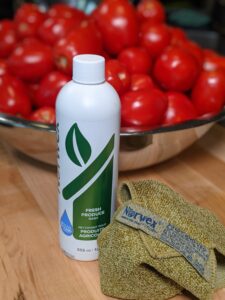
- Assemble the following items on the kitchen counter: a large pot to hold the chopped tomatoes, a smaller bowl for everything you discard, a cutting board, a sharp paring knife and of course, your cleaned tomatoes. Use a paring knife, remove from each tomato the stem scar and all blemishes. Quarter the tomato lengthwise so it is easy to remove any fibrous part. If the tomato is large, you can quarter it. It is really important to not use tomatoes that show signs of decay or mold.
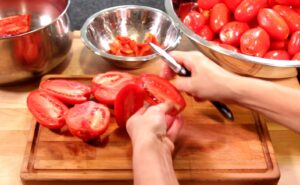
- Once your pot is full of tomatoes, place the lid on it and set it on the stove on low-medium heat. Bring the tomatoes to a boil, stirring often to prevent them from scorching. As the tomatoes soften, they will take less space so you can add any remaining chopped tomatoes. Simmer for about 15 to 20 minutes. The tomatoes will slowly begin to exude water. Use a ladle to remove as much water as you can. Don’t be surprised if you remove several cups of liquid. You can use this tomatoey-water to flavour soups or cook rice at a later time or discard.
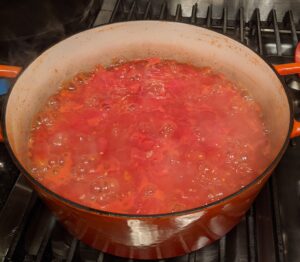
- Remove the pot from the heat. Use an immersion blender to break up the tomatoes but do not purée it completely. Be careful to not burn yourself as the tomatoes may splatter.
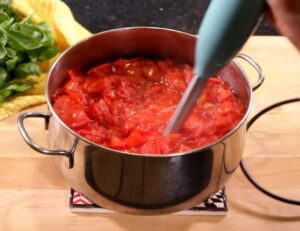
- Assemble the food mill using the fine sieve bottom plate. Place the assembled food mill on top of another large bowl or pot to fit snuggly. Using a large measuring cup or ladle, pour the cooked tomatoes into the food mill and start cranking the handle. Take precautions as the tomatoes can spit up a bit. Repeat this step until the accumulating seeds and skins are quite dry. Use a spatula to push the tomatoes that creep up the sides of the food mill on to the sieve plate to be processed by the food mill. Once the seeds and skins are dry, carefully tilt the food mill and with a spatula, scrape off the purée that has clung to the bottom of the sieve, allowing it to fall into the pot or bowl. Take care as to not let the remaining skins and seeds fall back in the purée.

Hot Water Method
- If using basil, place a few leaves of basil into each jar. Place the wide-mouth funnel on a jar and ladle the tomato purée, leaving about ½” headroom at the top. Repeat with remaining jars. Using a clean cloth or paper towel, wipe the rims of the jars clean and dry the lids to set on top. Apply the band to screw on until finger-tight. Do not over-tighten.
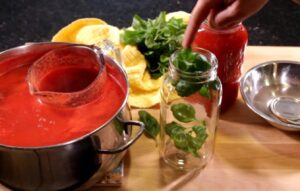
- In a large stock pot, lay a clean tea towel on the bottom. Fill the pot with tap water about one-third of the way. Carefully place the jars in the pot. Fill with water so that there is at least 1” of water above the top of the jars. Place another clean tea towel in between the jars so that do not rattle against each other. Put the lid on the pot and place on medium heat. Once the pot comes to a boil, let simmer for 40 minutes. Do not let the water level fall below the tops of the jars. Then shut off the heat and let the jars cool in the pot overnight. You can remove the jars earlier but you will need to take precautions by using a jar lifter as the jars are hot and slippery. Once removed from the pot, let the jars stand undisturbed for 24 hours. Check that they have sealed properly. See below.
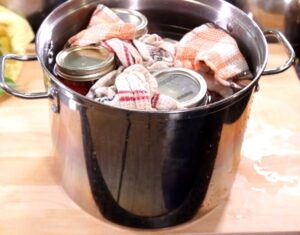
Quick Vacuum Method
- Coordinate the timing of the boiling with the dishwasher cycle of the jars as the jars must be sterilized. Once the cycle is complete, use oven mitts to place the jars on a rimmed baking sheet, lined with a clean kitchen towel. Allow jars to come to room temperature while passata is boiling. Have the lids soaking in a bowl with warm water. Do not boil the lids. Place a few leaves of basil into the jars. Bring the passata to a boil for about 10 minutes, stirring often. Place the wide-mouth funnel on a jar and ladle the hot purée into the jar. Leave about ½” headspace.
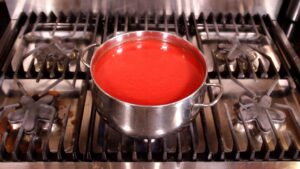
- Immediately, dry a lid and place it on the rim of the jar. Wipe the rim clean and dry. Dry the lid and place it on top of the rim. Apply the band to screw on until finger-tight. Do not over-tighten. Use an oven glove to handle the jar as it is extremely hot. Repeat filling and sealing one jar at a time. This way, the passata does not have a chance to cool off. Let the jars stand undisturbed for 24 hours. Check that they are sealed properly. See below.
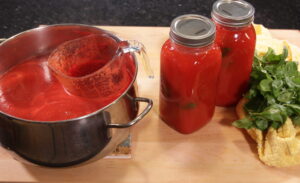
Freezer Method:
- Allow the passata to cool. Pour it into the bags, along with a few leaves of basil. Then carefully close the seal on the bag, pushing out as much air as possible. Lay flat on a cookie sheet and repeat the process. Place in a deep freezer. Once frozen, remove them from the cookie sheet and store in the freezer for upto a year.
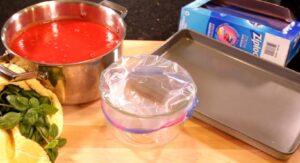
Video
Notes
Jars and Lids:
Check the jars for cracks or chips and check the two piece lids for dents or rust; these defects cause sealing failures or the jars to break.
Wash all jars in warm soapy water and rinse well. For the hot water method, sterilization of the jars is not required because you will be boiling the filled jars for about 45 minutes. For the quick vacuum method, jars must be sterilized. For either case, I use the dishwasher.
You can put the clean lids in a bowl with hot water. Do not boil the lids.
Extra passata:
If you have some purée leftover but not enough to fill the jar, you can pour it into a freezer bag to freeze for up to a year or store in the fridge for up to 2 days for a future recipe.
How do you know if the jars have sealed properly?
I check the lid to ensure that it is slightly concave as the vacuum created by the process sucks it in a bit. It should have no give when you use your finger to push on the centre of the lid. During the cooling time, you may even hear each jar “pop”. Should you notice that a jar has not sealed properly, you could use that passata immediately in a recipe. If you wish to try re-processing it, you will need to determine the origin of the problem first. Remove the band and lid and check to see if you missed noticing a chip on the jar’s rim. If this is the case, transfer the contents to another clean jar and reprocess it, making sure that both the rim and lid are clean and dry. If the rim of the jar was fine, ensure that there is only about ½” headspace and that the lid is centred properly before reprocessing. It is important to find these unsealed jars before storing them as the contents will then spoil quickly.
Storage:
If you are using jars to preserve the passata, you many notice some separation between the tomato pulp and liquid, especially if you did not remove enough liquid during the boiling stage of the chopped tomatoes. This is normal and will not harm the passata. If there is liquid, it will simply evaporate as you cook the passata in your recipe. Store the sealed jars in a cool, dark place for up to 1 year. Once opened, refrigerate and use within 3 days. Store the sealed jars in a cool, dark place for up to 1 year. Once opened, refrigerate and use within 3 days.
Produce wash and cloth:
Message me [email protected] if you would like to purchase the Norwex Produce Wash and/or the Veggie and Fruit Scrub Cloth
